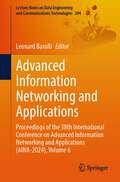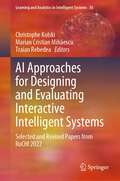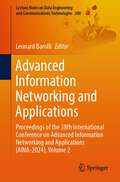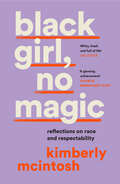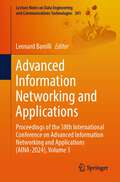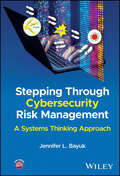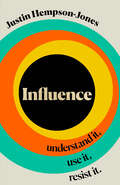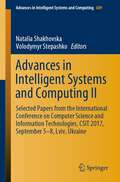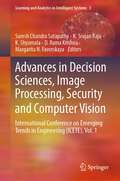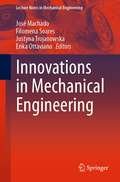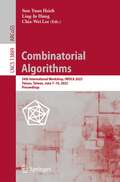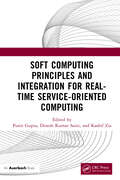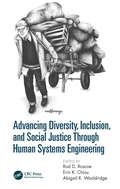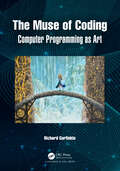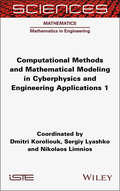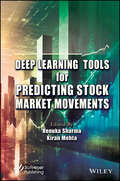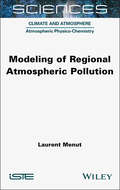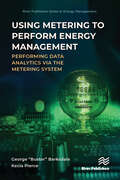- Table View
- List View
Advanced Information Networking and Applications: Proceedings of the 38th International Conference on Advanced Information Networking and Applications (AINA-2024), Volume 6 (Lecture Notes on Data Engineering and Communications Technologies #204)
by Leonard BarolliNetworks of today are going through a rapid evolution and there are many emerging areas of information networking and their applications. Heterogeneous networking supported by recent technological advances in low power wireless communications along with silicon integration of various functionalities such as sensing, communications, intelligence, and actuations are emerging as a critically important disruptive computer class based on a new platform, networking structure and interface that enable novel, low-cost and high-volume applications. Several of such applications have been difficult to realize because of many interconnection problems. To fulfill their large range of applications different kinds of networks need to collaborate and wired and next generation wireless systems should be integrated in order to develop high performance computing solutions to problems arising from the complexities of these networks. This book covers the theory, design and applications of computer networks, distributed computing, and information systems. The aim of the book “Advanced Information Networking and Applications” is to provide latest research findings, innovative research results, methods and development techniques from both theoretical and practical perspectives related to the emerging areas of information networking and applications.
AI Approaches for Designing and Evaluating Interactive Intelligent Systems: Selected and Revised Papers from RoCHI 2022 (Learning and Analytics in Intelligent Systems #36)
by Christophe Kolski Marian Cristian Mihăescu Traian RebedeaDesigning, building, and evaluating Interactive and Intelligent Systems (IIS) has highly impacted the progress of Artificial Intelligence (AI) techniques due to advancements in the fields of Deep Learning (DL) and Natural Language Processing (NLP). This book presents in a structured way several practical use cases of the interplay between IIS and DL/NLP, from cognitive assistants, adaptive navigation systems, virtual reality, offensive comment and cyberbullying detection, 3D modelling, and driving behaviour detection. The convergence of AI and Human-Computer Interaction (HCI) has been proven to foster the IIS development that nowadays represents the most used context by actively integrating AI techniques in merely any layer of modern applications.The main goal of this book is to provide a practical reference with a rich set of approaches and applications consisting of selected and revised papers from the International Conference on Human-Computer Interaction (RoCHI) 2022 thatwas held on 6-7 October 2022 at the University of Craiova, Romania. The book addresses researchers and practitioners with experience in IIS and AI (mainly DL and NLP) who want to study successfully developed workflows and applications that may be useful in their attempts to tackle issues from their contexts.Although the book nicely integrates concepts from various areas, each chapter may be considered a standalone topic with its research issue, proposed approach, experimental results, and discussions.
Advanced Information Networking and Applications: Proceedings of the 38th International Conference on Advanced Information Networking and Applications (AINA-2024), Volume 2 (Lecture Notes on Data Engineering and Communications Technologies #200)
by Leonard BarolliNetworks of today are going through a rapid evolution and there are many emerging areas of information networking and their applications. Heterogeneous networking supported by recent technological advances in low power wireless communications along with silicon integration of various functionalities such as sensing, communications, intelligence, and actuations are emerging as a critically important disruptive computer class based on a new platform, networking structure and interface that enable novel, low-cost and high-volume applications. Several of such applications have been difficult to realize because of many interconnection problems. To fulfill their large range of applications different kinds of networks need to collaborate and wired and next generation wireless systems should be integrated in order to develop high performance computing solutions to problems arising from the complexities of these networks. This book covers the theory, design and applications of computer networks, distributed computing, and information systems. The aim of the book “Advanced Information Networking and Applications” is to provide latest research findings, innovative research results, methods and development techniques from both theoretical and practical perspectives related to the emerging areas of information networking and applications.
black girl, no magic: reflections on race and respectability
by null Kimberly McIntosh'This book is a glowing achievement by one of the best essayists of her generation' Charlie Brinkhurst-Cuff ‘Witty, fresh and full of life’ Liv Little ‘I can’t recommend more highly… it’s one of those books that I just want to press in the hands of everybody’ Damian Barr, Literary Salon Podcast Kimberly McIntosh has lived a full life, with a loving family, messy friendships, mind-expanding travel and all-night parties. She’s also spent that life wondering why such opportunities aren’t always available to people who look like her. Stemming from years of social policy research and campaign work, this essay collection brings together all that Kimberly has learned; whether that’s dismantling the myth of social mobility for those who toe the line, to understanding why her teenage Facebook posts are quite so cringe. In it, she uses her own experiences to reveal how systematic injustice impacts us all, from the pressure of nuclear families, to enduring toxic friendships, to how painful it can be to watch Love Island. Perfect for fans of Slay In Your Lane, Trick Mirror, and Bad Feminist, this dazzling debut collection brilliantly melds the personal and political to not only tell the story of a life, but what that life might teach us.
Advanced Information Networking and Applications: Proceedings of the 38th International Conference on Advanced Information Networking and Applications (AINA-2024), Volume 3 (Lecture Notes on Data Engineering and Communications Technologies #201)
by Leonard BarolliNetworks of today are going through a rapid evolution and there are many emerging areas of information networking and their applications. Heterogeneous networking supported by recent technological advances in low power wireless communications along with silicon integration of various functionalities such as sensing, communications, intelligence, and actuations are emerging as a critically important disruptive computer class based on a new platform, networking structure and interface that enable novel, low-cost and high-volume applications. Several of such applications have been difficult to realize because of many interconnection problems. To fulfill their large range of applications different kinds of networks need to collaborate and wired and next generation wireless systems should be integrated in order to develop high performance computing solutions to problems arising from the complexities of these networks. This book covers the theory, design and applications of computer networks, distributed computing, and information systems. The aim of the book “Advanced Information Networking and Applications” is to provide latest research findings, innovative research results, methods and development techniques from both theoretical and practical perspectives related to the emerging areas of information networking and applications.
Stepping Through Cybersecurity Risk Management: A Systems Thinking Approach
by Jennifer L. BayukStepping Through Cybersecurity Risk Management Authoritative resource delivering the professional practice of cybersecurity from the perspective of enterprise governance and risk management. Stepping Through Cybersecurity Risk Management covers the professional practice of cybersecurity from the perspective of enterprise governance and risk management. It describes the state of the art in cybersecurity risk identification, classification, measurement, remediation, monitoring and reporting. It includes industry standard techniques for examining cybersecurity threat actors, cybersecurity attacks in the context of cybersecurity-related events, technology controls, cybersecurity measures and metrics, cybersecurity issue tracking and analysis, and risk and control assessments. The text provides precise definitions for information relevant to cybersecurity management decisions and recommendations for collecting and consolidating that information in the service of enterprise risk management. The objective is to enable the reader to recognize, understand, and apply risk-relevant information to the analysis, evaluation, and mitigation of cybersecurity risk. A well-rounded resource, the text describes both reports and studies that improve cybersecurity decision support. Composed of 10 chapters, the author provides learning objectives, exercises and quiz questions per chapter in an appendix, with quiz answers and exercise grading criteria available to professors. Written by a highly qualified professional with significant experience in the field, Stepping Through Cybersecurity Risk Management includes information on: Threat actors and networks, attack vectors, event sources, security operations, and CISO risk evaluation criteria with respect to this activity Control process, policy, standard, procedures, automation, and guidelines, along with risk and control self assessment and compliance with regulatory standards Cybersecurity measures and metrics, and corresponding key risk indicators The role of humans in security, including the “three lines of defense” approach, auditing, and overall human risk management Risk appetite, tolerance, and categories, and analysis of alternative security approaches via reports and studies Providing comprehensive coverage on the topic of cybersecurity through the unique lens of perspective of enterprise governance and risk management, Stepping Through Cybersecurity Risk Management is an essential resource for professionals engaged in compliance with diverse business risk appetites, as well as regulatory requirements such as FFIEC, HIIPAA, and GDPR, as well as a comprehensive primer for those new to the field. A complimentary forward by Professor Gene Spafford explains why “This book will be helpful to the newcomer as well as to the hierophants in the C-suite. The newcomer can read this to understand general principles and terms. The C-suite occupants can use the material as a guide to check that their understanding encompasses all it should.”
Mastering Project Discovery: Successful Discipline in Engineering and Analytics Projects
by Elliot Bendoly Daniel Bachrach Kathy Koontz Porter SchermerhornIntroducing a comprehensive approach to invigorate project leadership, this book provides a framework – the OUtCoMES Cycle – for developing, managing, advancing, and optimizing engineering and analytics projects.All too often, issues of moral hazard and completion bias prevent engineering and analytics managers and team leaders from asking the critical question 'What’s the problem?', before committing time, energy, and resources to solve it. This book draws attention to the definition, structuring, option consideration and ultimately the addressing of the right problems, exploring the OUtCoMES Cycle framework that facilitates and energizes systematic thinking, knowledge sharing, and on-the-fly adjustment with an explicit focus on the maximization of value and ROI. Each chapter includes discussions and lessons in analytical and engineering problem identification, problem structuring, iterative problem development (mental and computational) and problem resolution, at least three embedded real-world case studies, and a closing 'Practitioner’s Recap' to contextualize key chapter takeaways.Written by a team of established academic scholars and practicing analysts and engineers, this is an accessible and culture-shifting action guide for instructors interested in training the next generation of project and analytics leaders, students of analytics and engineering, as well as practicing project leaders and principals.
Mastering Project Discovery: Successful Discipline in Engineering and Analytics Projects
by Elliot Bendoly Daniel Bachrach Kathy Koontz Porter SchermerhornIntroducing a comprehensive approach to invigorate project leadership, this book provides a framework – the OUtCoMES Cycle – for developing, managing, advancing, and optimizing engineering and analytics projects.All too often, issues of moral hazard and completion bias prevent engineering and analytics managers and team leaders from asking the critical question 'What’s the problem?', before committing time, energy, and resources to solve it. This book draws attention to the definition, structuring, option consideration and ultimately the addressing of the right problems, exploring the OUtCoMES Cycle framework that facilitates and energizes systematic thinking, knowledge sharing, and on-the-fly adjustment with an explicit focus on the maximization of value and ROI. Each chapter includes discussions and lessons in analytical and engineering problem identification, problem structuring, iterative problem development (mental and computational) and problem resolution, at least three embedded real-world case studies, and a closing 'Practitioner’s Recap' to contextualize key chapter takeaways.Written by a team of established academic scholars and practicing analysts and engineers, this is an accessible and culture-shifting action guide for instructors interested in training the next generation of project and analytics leaders, students of analytics and engineering, as well as practicing project leaders and principals.
Influence: Understand it, Use it, Resist it
by null Justin Hempson-JonesOne of the government’s former behavioural scientists reveals how you can do what you want, whilst everybody tries to influence you into doing what they want. Influence makes you think what you think and do as you do. You use it to change the thoughts and behaviours of others – just as others use it change yours. We have been perfecting our influence for millions of years, but in the last 20 years digital technologies have revolutionised how influence works. We are now connected to old school friends and niche interest groups – but unwittingly also to organised criminals, terrorists and hostile states who infiltrate our societies. The course of history is being shaped: elections have been hijacked, lies spread about pandemics and the rapidly heating climate, and information has become as important as bullets and bombs to winning wars. More than ever, influence has become the crucial currency for commercial and political gain: If you don’t understand it, you will likely become its victim. Written by a former government behavioural scientist working at the cutting edge of this field, Influence is a groundbreaking guide to the chaotic and murky world we live in. Through examining five key factors we are taken on a tour from the past to our real-world present, to build a picture of the major role influence plays in everyday life. Influence provides a simple personal plan illustrating how you can use influence to achieve your goals – whether gaining that promotion, getting your friends to a music festival, or your children to eat their greens. But by understanding the nature of influence, you will also see how it is changing in the information age, enabling dangerous adversaries to gain power, leaving our societies in peril. Most importantly, by using the tools of influence you will be empowered to play your part in protecting us – it will be down to you and everyone you know. Influence is a fascinating guide to how you can help by understanding it, using it and resisting it.
Advances in Intelligent Systems and Computing II: Selected Papers from the International Conference on Computer Science and Information Technologies, CSIT 2017, September 5-8 Lviv, Ukraine (Advances in Intelligent Systems and Computing #689)
by Natalia Shakhovska Volodymyr StepashkoThis book reports on new theories and applications in the field of intelligent systems and computing. It covers computational and artificial intelligence methods, as well as advances in computer vision, current issues in big data and cloud computing, computation linguistics, and cyber-physical systems. It also reports on data mining and knowledge extraction technologies, as well as central issues in intelligent information management. Written by active researchers, the respective chapters are based on papers presented at the International Conference on Computer Science and Information Technologies (CSIT 2017), held on September 5–8, 2017, in Lviv, Ukraine; and at two workshops accompanying the conference: one on inductive modeling, jointly organized by the Lviv Polytechnic National University and the National Academy of Science of Ukraine; and another on project management, which was jointly organized by the Lviv Polytechnic National University, the International Project Management Association, the Ukrainian Project Management Association, the Kazakhstan Project Management Association, and Nazarbayev University. Given its breadth of coverage, the book provides academics and professionals with extensive information and a timely snapshot of the field of intelligent systems, and is sure to foster new discussions and collaborations among different groups.
Advances in Decision Sciences, Image Processing, Security and Computer Vision: International Conference on Emerging Trends in Engineering (ICETE), Vol. 1 (Learning and Analytics in Intelligent Systems #3)
by Suresh Chandra Satapathy K. Srujan Raju K. Shyamala D. Rama Krishna Margarita N. FavorskayaThis book constitutes the proceedings of the First International Conference on Emerging Trends in Engineering (ICETE), held at University College of Engineering and organised by the Alumni Association, University College of Engineering, Osmania University, in Hyderabad, India on 22–23 March 2019.The proceedings of the ICETE are published in three volumes, covering seven areas: Biomedical, Civil, Computer Science, Electrical & Electronics, Electronics & Communication, Mechanical, and Mining Engineering. The 215 peer-reviewed papers from around the globe present the latest state-of-the-art research, and are useful to postgraduate students, researchers, academics and industry engineers working in the respective fields. Volume 1 presents papers on the theme “Advances in Decision Sciences, Image Processing, Security and Computer Vision – International Conference on Emerging Trends in Engineering (ICETE)”. It includes state-of-the-art technical contributions in the area of biomedical and computer science engineering, discussing sustainable developments in the field, such as instrumentation and innovation, signal and image processing, Internet of Things, cryptography and network security, data mining and machine learning.
Innovations in Mechanical Engineering (Lecture Notes in Mechanical Engineering)
by José Machado Filomena Soares Justyna Trojanowska Erika OttavianoThis book covers a variety of topics in the field of mechanical engineering, with a special focus on methods and technologies for modeling, simulation, and design of mechanical systems. Based on a set of papers presented at the 1st International Conference “Innovation in Engineering”, ICIE, held in Guimarães, Portugal, on June 28–30, 2021, it focuses on innovation in mechanical engineering, spanning from engineering design and testing of medical devices, evaluation of new materials and composites for different industrial applications, fatigue and stress analysis of mechanical structures, and application of new tools such as 3D printing, CAE 3D models, and decision support systems. This book, which belongs to a three-volume set, provides engineering researchers and professionals with extensive and timely information on new technologies and developments in the field of mechanical engineering and materials.
Combinatorial Algorithms: 34th International Workshop, IWOCA 2023, Tainan, Taiwan, June 7–10, 2023, Proceedings (Lecture Notes in Computer Science #13889)
by Sun-Yuan Hsieh Ling-Ju Hung Chia-Wei LeeThis book constitutes the refereed proceedings of the 34th International Workshop on Combinatorial Algorithms, IWOCA 2023, held in Tainan, Taiwan, during June 7–10, 2023. The 33 full papers included in this book were carefully reviewed and selected from 86 submissions. They were organized in topical sections as follows: algorithms and data structures; algorithmic and combinatorical aspects of cryptography and information security; algorithmic game theory and complexity of games; approximation algorithms; complexity theory; combinatorics and graph theory; combinatorial generation, enumeration and counting; combinatorial optimization; combinatorics of words; computational biology; computational geometry; decompositions and combinatorial designs; distributed and network algorithms; experimental combinatorics; fine-grained complexity; graph algorithms and modelling with graphs; graph drawing and graph labelling; network theoryand temporal graphs; quantum computing and algorithms for quantum computers; online algorithms; parameterized and exact algorithms; probabilistic and randomized algorithms; and streaming algorithms.
Software Development with UML
by Ken LunnThis is an introductory book to information modelling with UML, for entry level university students. It assumes no previous knowledge of UML on the part of the reader, and uses a case-based approach to present the material clearly and accessibly. It harmonises the UML notation with a full software development approach, from project conception through to testing, deployment and enhancement. The author is an experienced tutor, who also practices as a UML professional, and the cases are based upon his own experience.The book is accompanied by a website that provides solutions to end-of-chapter exercises, a password-protected tutor's file of further exercises with solutions, slides to accompany the book, and other support material.This book is suitable for all undergraduate computing and information systems, or Software Engineering courses. First year students will find it particulalry helpful for modules on systems development or analysis and design.
Soft Computing Principles and Integration for Real-Time Service-Oriented Computing
by Punit Gupta Dinesh Kumar Saini Kashif ZiaIn recent years, soft computing techniques have emerged as a successful tool to understand and analyze the collective behavior of service- oriented computing software. Algorithms and mechanisms of self- organization of complex natural systems have been used to solve problems, particularly in complex systems, which are adaptive, ever- evolving, and distributed in nature across the globe. What fits more perfectly into this scenario other than the rapidly developing era of Fog, IoT, and Edge computing environment? Service- oriented computing can be enhanced with soft computing techniques embedded inside the Cloud, Fog, and IoT systems.Soft Computing Principles and Integration for Real-Time Service-Oriented Computing explores soft computing techniques that have wide application in interdisciplinary areas. These soft computing techniques provide an optimal solution to the optimization problem using single or multiple objectives.The book focuses on basic design principles and analysis of soft computing techniques. It discusses how soft computing techniques can be used to improve quality-of-service in serviceoriented architectures. The book also covers applications and integration of soft computing techniques with a service- oriented computing paradigm. Highlights of the book include: A general introduction to soft computing An extensive literature study of soft computing techniques and emerging trends Soft computing techniques based on the principles of artificial intelligence, fuzzy logic, and neural networks The implementation of SOC with a focus on service composition and orchestration, quality of service (QoS) considerations, security and privacy concerns, governance challenges, and the integration of legacy systems The applications of soft computing in adaptive service composition, intelligent service recommendation, fault detection and diagnosis, SLA management, and security Such principles underlying SOC as loose coupling, reusability, interoperability, and abstraction An IoT based framework for real time data collection and analysis using soft computing
Advancing Diversity, Inclusion, and Social Justice Through Human Systems Engineering
by Rod D. Roscoe Erin K. Chiou Abigail R. WooldridgeWinner of the "Outstanding Academic Title" recognition by Choice for the 2020 OAT Awards. The Choice OAT Award represents the highest caliber of scholarly titles that have been reviewed by Choice and conveys the extraordinary recognition of the academic community.Advancing Diversity, Inclusion, and Social Justice through Human Systems Engineering highlights how scholars and practitioners of HSE (inclusively defined to span many fields) can apply their theories and methods to understand and support healthy communities, include and empower diverse populations, and inspire strategies for a more inclusive future. This volume brings together experts from human factors, ergonomics, psychology, human-computer interaction, and more to demonstrate how these fields can be applied to societal challenges and solutions. Through a blend of research reports, literature reviews, and personal narratives, this volume explores these issues from the individual to the global scale, across diverse populations, and across multiple continents. Features Draws upon human factors and ergonomics theories and methods to evaluate, understand, and confront systemic threats to inclusion and social justice Offers actionable methodologies, strategies, and recommendations for conducting human-centered research, design, and training with marginalized or vulnerable populations Offers a venue for reporting and reconsidering the work of human factors and ergonomics from the perspectives of diversity, inclusion, and social justice
The Muse of Coding: Computer Programming as Art
by Richard GarfinkleThis book gives students and experienced programmers a way to see coding as an art and themselves as artists whose personal views, experiences, and ways of thinking can make their programs better for themselves and their users.This book shows in a good-humored and sympathetic way how the artistic and practical sides of programming are the same, delving into the methods of coding, the history of art, and the ways in which artists and audiences interact and benefit each other.Not confined to a single language or style of coding, this book provides a widely applicable framework for people to learn what languages and styles work best for them at present and as the field evolves. It can be used as a classroom text or for personal study and enrichment.
Grundlagen des Quantencomputing für Dummies (Für Dummies)
by whurley Floyd Earl SmithTauchen Sie ein in die Welt des Quantencomputing! In diesem Buch erfahren Sie, wieso Quantencomputer Probleme lösen können, für die Supercomputer Millionen von Jahren brauchen würden. Die Autoren zeigen Ihnen, welche wirtschaftlichen Potenziale das Quantencomputing für Ihr Unternehmen birgt und wie es Ihre Arbeit unterstützen kann. Sie vermitteln Ihnen nicht nur die Grundlagen, sondern zeigen Ihnen ganz konkret, wie das Quantencomputing Industrien wie das Finanzwesen, Transportwesen, die Pharmazie und Cybersecurity transformieren wird. Um Quantencomputing und sein Potenzial verstehen zu können, benötigen Sie keinen Doktortitel, sondern nur dieses Buch. Sie erfahren Welche Arten von Quantencomputern existieren und was sie unterscheidet Was Quantencomputing schon heute kann Wie Sie Ihr Unternehmen auf Quantencomputing vorbereiten Wie Sie Ihr erstes eigenes Quantencomputing-Programm schreiben
Data Analysis and Related Applications 3: Theory and Practice, New Approaches
by Yiannis Dimotikalis Christos H. SkiadasThe book is a collective work by a number of leading scientists, analysts, engineers, mathematicians and statisticians who have been working at the forefront of data analysis and related applications, arising from data science, operations research, engineering, machine learning or statistics. The chapters of this collaborative work represent a cross-section of current research interests in the above scientific areas. The collected material has been divided into appropriate sections to provide the reader with both theoretical and applied information on data analysis methods, models and techniques, along with appropriate applications. The published data analysis methodology includes the updated state-of-the-art rapidly developed theory and applications of data expansion, both of which go through outstanding changes nowadays. New approaches are expected to deliver and have been developed, including Artificial Intelligence.
Computational Methods and Mathematical Modeling in Cyberphysics and Engineering Applications 1
by Dmitri Koroliouk Sergiy Lyashko Nikolaos LimniosMathematical methods in engineering are characterized by a wide range of techniques for approaching various problems. Moreover, completely different analysis techniques can be applied to the same problem, which is justified by the difference in specific applications. Therefore, the study of the analyses and solutions of specific problems leads the researcher to generate their own techniques for the analysis of similar problems continuously arising in the process of technical development. Computational Methods and Mathematical Modeling in Cyberphysics and Engineering Applications contains solutions to specific problems in current areas of computational engineering and cyberphysics.
Deep Learning Tools for Predicting Stock Market Movements
by Renuka Sharma Kiran MehtaDEEP LEARNING TOOLS for PREDICTING STOCK MARKET MOVEMENTS The book provides a comprehensive overview of current research and developments in the field of deep learning models for stock market forecasting in the developed and developing worlds. The book delves into the realm of deep learning and embraces the challenges, opportunities, and transformation of stock market analysis. Deep learning helps foresee market trends with increased accuracy. With advancements in deep learning, new opportunities in styles, tools, and techniques evolve and embrace data-driven insights with theories and practical applications. Learn about designing, training, and applying predictive models with rigorous attention to detail. This book offers critical thinking skills and the cultivation of discerning approaches to market analysis. The book: details the development of an ensemble model for stock market prediction, combining long short-term memory and autoregressive integrated moving average; explains the rapid expansion of quantum computing technologies in financial systems; provides an overview of deep learning techniques for forecasting stock market trends and examines their effectiveness across different time frames and market conditions; explores applications and implications of various models for causality, volatility, and co-integration in stock markets, offering insights to investors and policymakers. Audience The book has a wide audience of researchers in financial technology, financial software engineering, artificial intelligence, professional market investors, investment institutions, and asset management companies.
Modeling of Regional Atmospheric Pollution
by Laurent MenutThis book describes the main concepts used to develop and implement chemistry-transport models to calculate the evolution of regional air pollution. Since physico-chemical principles are already widely presented in various works, the perspective chosen for this book concerns the modeling of these processes. As modeling can be a simplification of reality in a particular study framework, we will try to show whether the processes represented are well modeled or not. For each process, we will discuss the simplifying assumptions that have been made, the various possible ways for improvement and the impact of these simplifications on the desired results. General information on pollution is presented, followed by observations, legislation, modeling of meteorology and then chemistry-transport, anthropogenic and natural emissions, depots, validation of calculations, optimization and data assimilation.
Data Analysis and Related Applications 3: Theory and Practice, New Approaches
by Yiannis Dimotikalis Christos H. SkiadasThe book is a collective work by a number of leading scientists, analysts, engineers, mathematicians and statisticians who have been working at the forefront of data analysis and related applications, arising from data science, operations research, engineering, machine learning or statistics. The chapters of this collaborative work represent a cross-section of current research interests in the above scientific areas. The collected material has been divided into appropriate sections to provide the reader with both theoretical and applied information on data analysis methods, models and techniques, along with appropriate applications. The published data analysis methodology includes the updated state-of-the-art rapidly developed theory and applications of data expansion, both of which go through outstanding changes nowadays. New approaches are expected to deliver and have been developed, including Artificial Intelligence.
Applied Reconfigurable Computing. Architectures, Tools, and Applications: 20th International Symposium, ARC 2024, Aveiro, Portugal, March 20–22, 2024, Proceedings (Lecture Notes in Computer Science #14553)
by Iouliia Skliarova Piedad Brox Jiménez Mário Véstias Pedro C. DinizThis LNCS conference volume constitutes the proceedings of the 20th International Symposium, ARC 2024, in Aveiro, Portugal, in March 2024. The 16 full papers together with 5 papers from the technical program included in this volume were carefully reviewed and selected from 24 submissions. The conference focuses on the application and development of reconfigurable computing techniques, fault-tolerance, data, and graph processing acceleration to computer security.
Using Metering to Perform Energy Management: Performing Data Analytics via the Metering System (River Publishers Series in Energy Management)
by George “Buster” Barksdale Kecia PierceThis book covers many helpful analysis tools and processes to assist energy managers (EMs) administer their energy program through their meter management system (MMS). These tools and the corresponding techniques offer opportunities for the EM to optimize their time. If fully utilized, the MMS will allow an EM to reduce field time significantly, as they can perform most of the energy management pre-analysis, benchmarking, data analysis and, in many cases, complete the task of performing a virtual audit remotely from their office.The book covers many instructional areas that are, for the most part, only offered by consulting groups and software vendors as services. Those two groups offer their services for fees and therefore do not publish their ideas or best practices for commercial use. Software vendors provide software analytics whose functional aspects are addressed by our descriptions of the essential tasks in each chapter. This book allows EMs to expand their knowledge of software capabilities by viewing other best practices. Consulting groups offer services in a few areas: basic benchmarking and monitoring-based commissioning (MBCx). These services are considered essential to energy management but are generally implemented as on-site services, which, due to their nature, are much more expensive than a monitoring commissioning (MCx) solution. Monitoring commissioning, in contrast to MBCx, is purely done at the monitoring level and allows you to manage the critical energy measures that comprise the majority of the savings, but without getting into the field testing.Benchmarking is covered much deeper in the book as we show how to benchmark each system within a building. The benchmarking sections show how to automatically analyze each system’s usage into a separate benchmark for baseload, lighting, AC, and fan/pump systems. These systems produce benchmarks so EMs can compare by site, category type, climate zone, etc. We also introduce benchmarks that enable the EM to utilize tools to determine the performance of each system and which are their most significant energy users. These analytics functions are covered to produce results that identify potential energy savings for each energy system.
